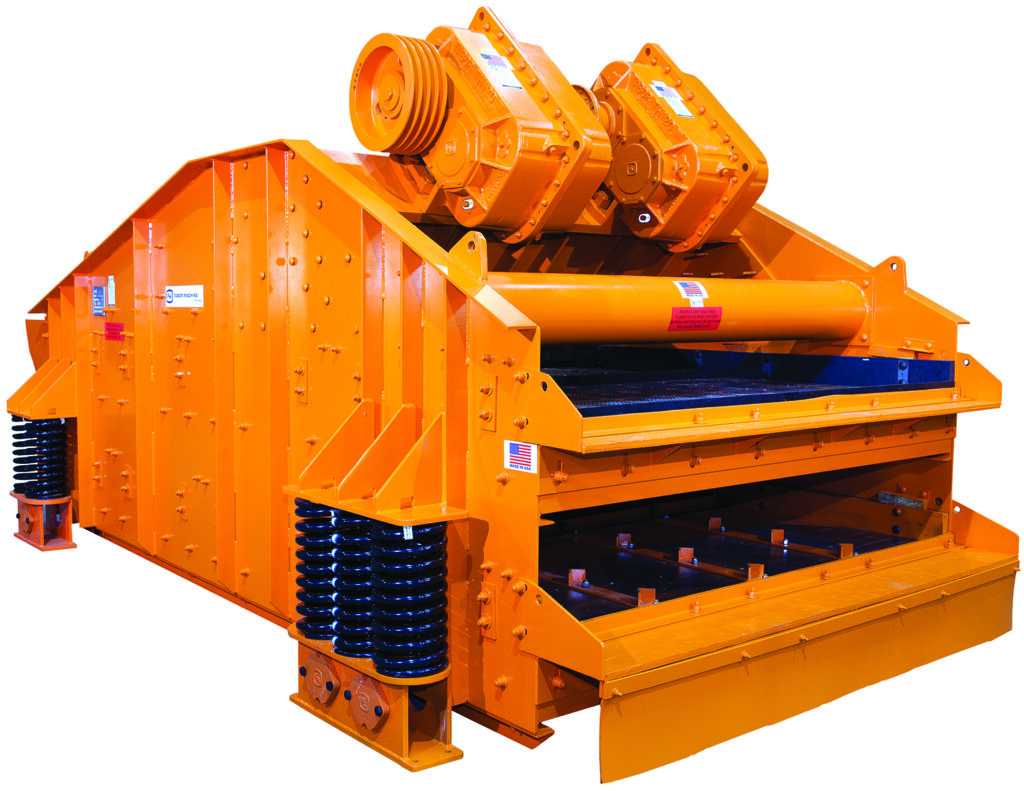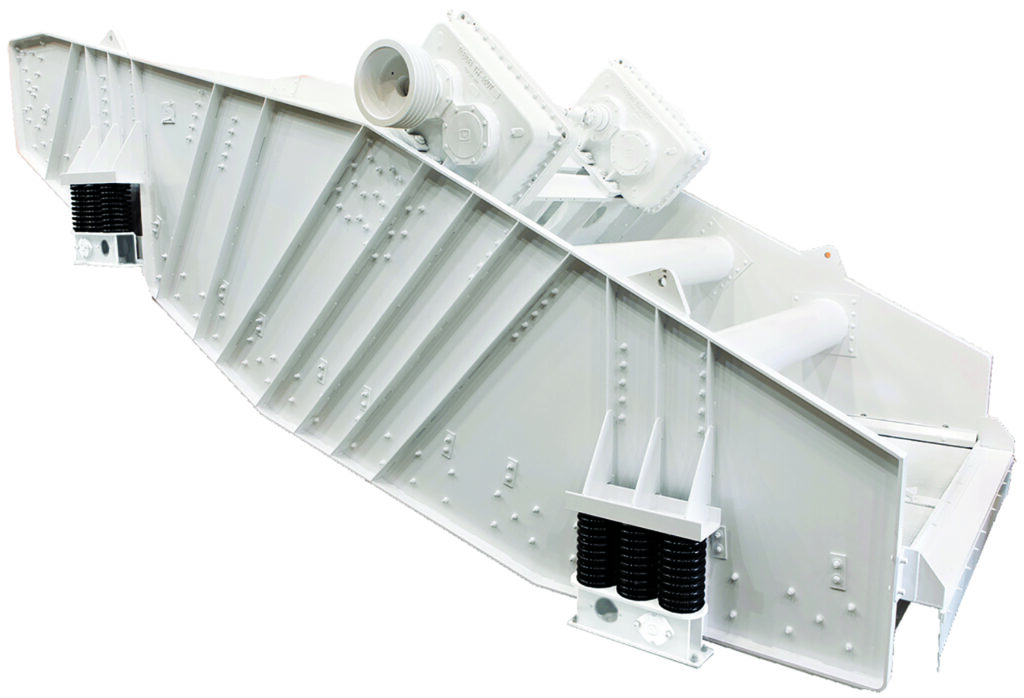
Horizontal vibrating screens are a core component for magnetite recovery and material dewatering processes. (Photo: Elgin Separation Solutions)
By Kimberly V. Althage
In the dynamic realm of coal preparation, maintaining peak operational efficiency is paramount. Vibrating screens play pivotal roles in this diverse landscape, ensuring consistent processing capacity and product quality. Implementing routine procedures during operation maintenance is not just a strategy but a necessity to maximize performance and mitigate downtime. The following recommendation can improve efficiency and aviability with vibrating screens.
Know the Equipment Parameters
Horizontal vibrating screens are a core component for magnetite recovery and material dewatering processes. Its design focuses on high-volume processing in limited spaces while ensuring reliability. It supports various screen media types like profile wire, punch plate, or modular polyurethane panels, enabling seamless integration for different materials and tasks. Its primary function lies in the initial separation and sizing of coarse materials, essential for efficient coal preparation.
Inclined vibrating screens can be used for scalping, sizing, desliming, or drain-and-rinse applications. Linear motion screens are suitable for high-volume processing in constrained spaces, while circular motion screens excel at preventing material blockages during scalping. Elliptical motion screens offer adjustable feed and discharge speeds.
Multi-slope vibrating screens specialize in handling larger feed quantities efficiently. Its “banana” shape promotes material stratification and fines separation, and is ideal for tasks like raw coal processing, desliming, draining, and rinsing.
Reverse incline dewatering screens optimize desliming, dewatering, and fines recovery from effluent with modular screen panels. They support various interchangeable screen media, producing consistent products with controlled moisture levels.
Horizontal vibratory centrifuges (HVC) specializes in dewatering larger particles, intermediates, and ultrafine materials efficiently. It offers simplified maintenance, customizable configurations, and durable components for maintenance-free operation making it ideal for coarse particle circuits in coal preparation.
 No Two Plants are Alike
No Two Plants are Alike
In the coal preparation industry, operational challenges are constant, because conditions differ widely across mines and coal types. Variations in coal properties, such as calorific values (Btu/lb), exhibit significant regional disparities; for example, coal from the Illinois Basin typically has a lower calorific than in other regions. Sulfur content also fluctuates significantly, ranging from less than 1% to more than 2% in different areas. These differences require tailored approaches, where equipment specifications must align with the specific geological and compositional characteristics of the coal being processed. This includes selecting appropriate screen sizes or configurations that best suit the application, ensuring optimal performance and efficiency in coal preparation operations.
Residence time, which refers to how long material stays on the screen during processing, is crucial across all equipment in a plant, especially vibrating screens to vibratory centrifuges. Maximizing residence time optimizes operations, but it’s a constantly moving target, especially in plants sourcing from multiple mines with varying geologies. Adjustments such as gravity and feed rates ensure efficiency across changing conditions, making it a constant challenge to manage effectively.
The hardness of coal, known as grind, varies significantly depending on the geological characteristics of the area. For instance, coal in Virginia, central West Virginia, and northern West Virginia can have drastically different hardness levels. This impacts the average lifespan of equipment like screens, with each plant developing its own unique operational characteristics based on the feed material and mine sources. This variability necessitates careful consideration in equipment selection and maintenance, as what works for one plant may not be suitable for another due to these geological and material variations.
 Some Maintenance Required
Some Maintenance Required
Inspections and maintenance schedules in coal preparation plants vary significantly based on the specific application and equipment involved. While vibrating screens may require weekly inspections, others like the HVC might only need attention every six months. Inspection doors provide convenient visual monitoring, and the frequency and method of inspections are determined case by case, tailored to each setup’s unique needs and operational demands.
The heart of a vibrating screen are the exciter motors, which provides high G’s on the screen decks for material processing. Ensuring these motors are well-maintained is vital. Issues like inadequate oil changes or failing bearings can lead to premature vibration problems, or worse yet, downtime. During plant visits, a good service technician uses tools like stethoscopes and heat guns to detect any potential motor failures. Similarly, drive units, housing mechanisms with gears, counterweights, and belt-driven systems powered by electric motors, are crucial components in all our machines. Regular oil changes, though not as frequent as in automobile engines, are essential for their upkeep due to limited oil capacity. Monitoring these units closely is imperative to prevent significant problems that could arise from even minor oil loss.
In the coal preparation process, the wear on a cyclone’s apex can significantly impact separation efficiency, allowing more clays and foreign materials to reach the centrifuge. This accumulation can blind the centrifuge, leading to higher moisture levels in the final product. It’s crucial to recognize that issues often stem from the preceding circuit, highlighting the importance of closely monitoring upstream components. Problems with equipment downstream, such as screens or centrifuges, are often traceable to issues earlier in the processing line, like a worn cyclone affecting separation efficiency. Simply shutting off problematic equipment can worsen the situation, emphasizing the need for comprehensive problem-solving and understanding the interconnectedness of equipment in the processing circuit. Addressing issues holistically is key to optimizing performance in coal preparation plants.

Multi-slope vibrating screens are ideal for tasks like raw coal processing, as well as desliming, and drain-and-rinse applications. (Photo: Elgin Separation Solutions)
What is That Sound
Understanding the intricacies of equipment is paramount for plant operators, as it forms the foundation of efficient operations. This knowledge extends to recognizing the unique characteristics or “personality” of each machine. This often begins with familiarizing oneself with its sounds and behaviors. When operators become attuned to the usual hum of normal operation, they can quickly identify issues like loose screen wedges or failing deck springs by changes in sound. This keen sense of sound awareness becomes instinctual over time, allowing operators to detect irregularities such as rattling, grinding, or thumping, which could indicate underlying problems.
Being able to pinpoint these anomalies is critical, as they can escalate into downtime and operational disruptions if not addressed promptly. Some operators learn these sounds through experience, often after facing equipment malfunctions. Proactive maintenance strategies, such as periodic noise level checks and using diagnostic tools like heat guns and stethoscopes, help in identifying and replacing faulty components before they lead to major failures. Delaying maintenance until equipment becomes noticeably loud is a risk to avoid, as it can result in higher rebuild costs and prolonged downtime.
The key takeaway is that plant operators must learn the “personality” and traits of each machine, understanding its typical sounds and behaviors. This familiarity allows for effective monitoring and early detection of issues, preventing potential breakdowns and ensuring smooth plant operations.
 Consistent Routines are Best
Consistent Routines are Best
In large-scale operations that run 24/7, comprehensive maintenance is conducted weekly, dedicating a 12-hour window to screen inspections and replacements. The diligent screen crew meticulously examines every vibrating screen surface, promptly swapping out worn panels to maintain optimal performance. This routine check on downshifts includes inspecting mechanisms, drive belts, breathers for any blockages, and ensuring the integrity of coil springs. These measures are crucial given the intensive production schedule, ensuring uninterrupted operations and minimizing downtime due to equipment issues.
Vibrating screens are designed to operate within specific limits, such as stroke, speed, inclination, screening media types and openings. The operating manuals and drawings for your particular screen provide these specifications. Refer to this data before operating your screen or before making any major changes in the screen’s original intended function, deck openings, type of deck surface, feed, sizes, or tonnage. Here are some tips to ensure smooth operation and maintenance.
The coal preparation industry thrives on meticulous maintenance practices that not only sustain equipment longevity but also optimize operational efficiency. Operational challenges stemming from variations in coal properties like BTU levels and sulfur content necessitate tailored maintenance strategies, ensuring equipment resilience across diverse geological and compositional characteristics.
Routine inspections and proactive problem-solving are foundational to preempting downtime and maintaining uninterrupted operations. Getting familiar with equipment “personality” through sound awareness aids in early issue detection, minimizing the risk of major failures and costly rebuilds.
In essence, embracing best practice operation and maintenance in coal preparation is not just about sustaining equipment; it’s about fostering a culture of operational excellence and resilience, ensuring seamless operations amid dynamic challenges within the industry.
Althage is the marketing manager for TerraSource Global.


